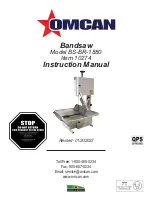
20
www.romus.fr
GB
©
Precision Tools Ltd. 2013
6
Line Following
1. Pointers at the front and rear of the guard allow a line to be followed, when cutting. (
Dia-
gram H
)
2. For more accurate and neater cutting a metal ruler, held with the free hand, can be fol-
lowed. To position the ruler draw a second line 10 mm to the left of the cutting line. (Or 33
mm to the right of the cutting line for left handed operators.) (
Diagram I
)
Measuring the Cutting Width
When making cut outs it is desirable to know exactly where the cut will start and stop to
prevent unsightly over cutting. Indication numbers, which correspond to the depth setting,
are marked on both sides of the guard to show where the blade starts and stops. (
Diagram J
)
1. Mark the area to be cut out on the material to be cut. If the area is not a square or rectan-
gle, separate start and finish lines may have to be drawn. These are drawn from the start and
finish point, at right angles to the line of cut.
2. To use the width indication system first set the cutting depth, (
See Setting the Cutting
Depth Section
) for example, to 9 mm.
3. Identify this number (e.g. 9) both on the front and rear of the guard.
4. Align the indication mark below the rearmost number on the guard with the start line on
the material to be cut.
5. Proceed with the cut until the indication mark below the forward number aligns with the
finish line on the material being cut.
Cut-outs
NB. Plunge cutting may not be possible in some hard materials.
1. Set the depth of cut, (
See Setting the Cutting Depth Section
) plug in the mains sup-
ply and then place the metal base plate onto the work surface. Ensure that the rear width
indication mark on the guard aligns with the start line. (
See Measuring the Cutting Width
Section
) To ensure accurate cut-outs the guard can be held with the free hand, but ensure it
does not come into contact with the blade.
2. Switch on the tool and wait for one second for the blade to run up to speed. Next, plunge
the blade into the material slowly and gently, but firmly. Then push the tool forwards along
the line to be cut. (Never draw the tool backwards)
3. Once the finish line has been reached, lift the tool from the work surface before switching
off. If a lot of dust has been created, keep switched on for a few seconds extra to allow the
dust to clear from within the tool.
4. Cutting out tips:
• If the cut is to be covered, for example by a vent cover, the corners can be overlapped to
ensure that the waste material is completely detached.
• If the cut out is to be seen, do not overlap the corners. In this circumstance, as the cutting
blade is circular, the waste material will not be fully detached. The corners will therefore,
require finishing with a knife. If the material is thin and the back surface unimportant, the
waste material can just be pushed out.
scie exaRk suR BatteRie «ec 18V»
exakt «ec 18V» coRdless saW
ZaaG exakt Met BatteRiJ «ec 18V»
Réf 93690















































